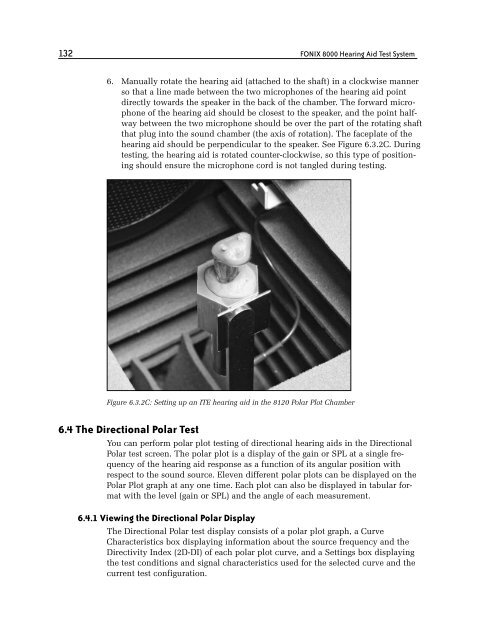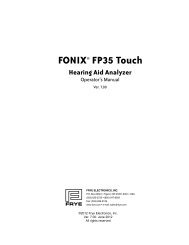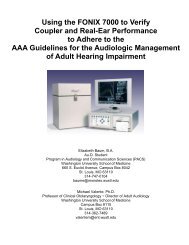FONIX® 8000 - Frye Electronics
FONIX® 8000 - Frye Electronics
FONIX® 8000 - Frye Electronics
Create successful ePaper yourself
Turn your PDF publications into a flip-book with our unique Google optimized e-Paper software.
132 FONIX <strong>8000</strong> Hearing Aid Test System<br />
6. Manually rotate the hearing aid (attached to the shaft) in a clockwise manner<br />
so that a line made between the two microphones of the hearing aid point<br />
directly towards the speaker in the back of the chamber. The forward microphone<br />
of the hearing aid should be closest to the speaker, and the point halfway<br />
between the two microphone should be over the part of the rotating shaft<br />
that plug into the sound chamber (the axis of rotation). The faceplate of the<br />
hearing aid should be perpendicular to the speaker. See Figure 6.3.2C. During<br />
testing, the hearing aid is rotated counter-clockwise, so this type of positioning<br />
should ensure the microphone cord is not tangled during testing.<br />
Figure 6.3.2C: Setting up an ITE hearing aid in the 8120 Polar Plot Chamber<br />
6.4 The Directional Polar Test<br />
You can perform polar plot testing of directional hearing aids in the Directional<br />
Polar test screen. The polar plot is a display of the gain or SPL at a single frequency<br />
of the hearing aid response as a function of its angular position with<br />
respect to the sound source. Eleven different polar plots can be displayed on the<br />
Polar Plot graph at any one time. Each plot can also be displayed in tabular format<br />
with the level (gain or SPL) and the angle of each measurement.<br />
6.4.1 Viewing the Directional Polar Display<br />
The Directional Polar test display consists of a polar plot graph, a Curve<br />
Characteristics box displaying information about the source frequency and the<br />
Directivity Index (2D-DI) of each polar plot curve, and a Settings box displaying<br />
the test conditions and signal characteristics used for the selected curve and the<br />
current test configuration.
















